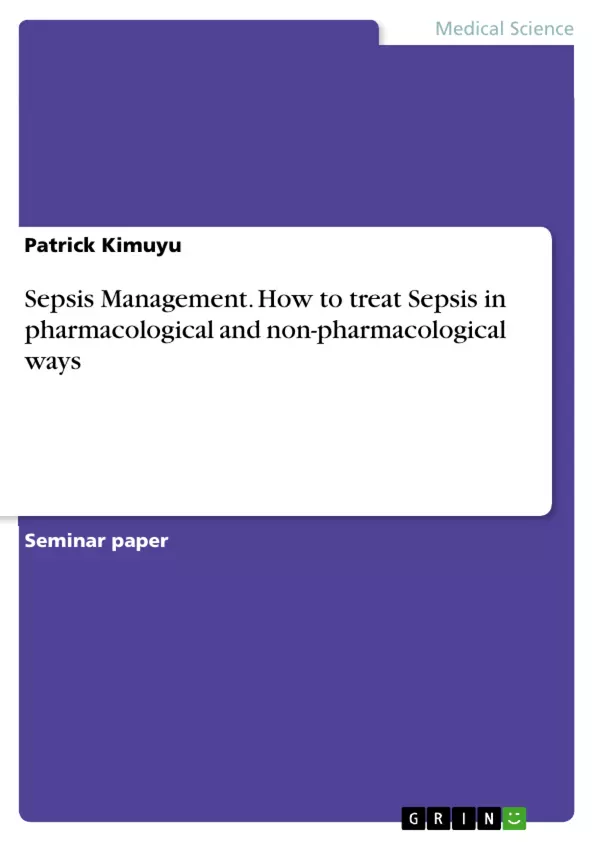Sepsis is believed to be one of the most life-threatening medical conditions. This condition is associated with an infection that triggers inflammation responses leading to inflammations in different body parts and organs. In most cases, bacterial infections serve as the causes of sepsis. In practice, sepsis can be viewed as a condition that occur in three stages with sepsis progressing into severe sepsis and then septic shock that is characterized by organ failure. Evidence indicates that incidences for severe sepsis and septic shock have increased rapidly in the past decade and this is attributable to the increase of the aging population. As a result, severe sepsis and septic shock are considered some of the most causes of mortality and morbidity in intensive care. This phenomenon has prompted physicians and professional societies to implement management procedures that focus on early intervention. Therefore, this presentation will provide a comprehensive discussion on pharmacological and non pharmacological treatment of sepsis.
Inhaltsverzeichnis (Table of Contents)
- INTRODUCTION
- Prognosis of Sepsis
- PHARMACOLOGICAL AND NON PHARMACOLOGICAL TREATMENT OF SEPSIS
- EARLY MANAGEMENT
- Respiration Support
- Assessment of Perfusion
- Establishment of Venous Access
- Urinary Catheterization
- Fluid Resuscitation
- Early goal-directed therapy (EGDT)
- Vasopressor Therapy
- Inotropic Therapy
- Red Blood Cell Transfusions
- CONTROL OF THE SEPTIC FOCUS
- Identification of the Septic Focus (Diagnosis)
- Antimicrobial Therapy
- ADDITIONAL THERAPIES
- Corticosteroid Therapy
Zielsetzung und Themenschwerpunkte (Objectives and Key Themes)
This presentation provides a comprehensive discussion on pharmacological and non-pharmacological treatment of sepsis, focusing on early intervention and evidence-based practices for effective sepsis management. It aims to create understanding on international sepsis management guidelines, appropriate interventions, and empower nurses to offer patient-centered care.
- Early intervention and management of sepsis
- Pharmacological and non-pharmacological treatment strategies
- Evidence-based practices in sepsis management
- International sepsis management guidelines
- Patient-centered care in sepsis treatment
Zusammenfassung der Kapitel (Chapter Summaries)
- INTRODUCTION: This section introduces sepsis as a life-threatening condition caused by an infection that triggers an inflammatory response. It highlights the increasing incidence of severe sepsis and septic shock, emphasizing the importance of early intervention and management.
- Prognosis of Sepsis: This section discusses the systemic inflammatory response (SIRS) criteria and the MEDS (Mortality in Emergency Department Sepsis) score used to assess the severity of sepsis.
- PHARMACOLOGICAL AND NON PHARMACOLOGICAL TREATMENT OF SEPSIS: This section focuses on the rationale and interventions for sepsis treatment, primarily in severe sepsis and septic shock. It includes discussions on early management strategies like respiration support, assessment of perfusion, establishment of venous access, urinary catheterization, and fluid resuscitation.
- EARLY MANAGEMENT: This section explores various early management strategies like respiration support, assessment of perfusion, establishment of venous access, urinary catheterization, and fluid resuscitation.
- CONTROL OF THE SEPTIC FOCUS: This section discusses the importance of identifying the etiological agent and site of infection for primary therapeutic interventions. It emphasizes the use of diagnostic tests and antimicrobial therapy.
- ADDITIONAL THERAPIES: This section explores the rationale and use of corticosteroid therapy in sepsis management.
Schlüsselwörter (Keywords)
The primary focus of this work is on sepsis management, emphasizing early intervention, evidence-based practices, and patient-centered care. Key terms include sepsis, severe sepsis, septic shock, SIRS criteria, MEDS score, pharmacological treatment, non-pharmacological treatment, respiration support, perfusion, fluid resuscitation, vasopressor therapy, inotropic therapy, antimicrobial therapy, corticosteroid therapy, and international sepsis management guidelines.
- Quote paper
- Patrick Kimuyu (Author), 2018, Sepsis Management. How to treat Sepsis in pharmacological and non-pharmacological ways, Munich, GRIN Verlag, https://www.grin.com/document/388557



